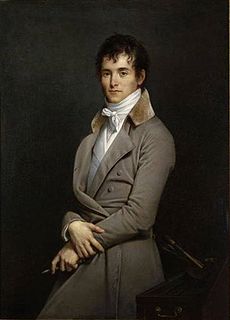art.wikisort.org - Artist
Pierre-Narcisse, baron Guérin (13 March 1774 – 6 July 1833) was a French painter born in Paris.
Pierre-Narcisse, baron Guérin | |
|---|---|
 Portrait of Guérin by Robert Lefèvre, 1801 | |
| Born | 13 March 1774 Paris, France |
| Died | 6 July 1833 (aged 59) Rome, Papal States |
| Nationality | French |
| Known for | Painting |
| Notable work | Jeune fille en buste |
Background
A pupil of Jean-Baptiste Regnault, he carried off one of the three grands prix offered in 1796, in consequence of the competition not having taken place since 1793. In 1799, his painting Marcus Sextus (Louvre) was exhibited at the Salon and excited wild enthusiasm. Part of this was due to the subject – a victim of Sulla's proscription returning to Rome to find his wife dead and his house in mourning – in which an allusion was found to the turmoil of the French Revolution.

Guérin on this occasion was publicly crowned by the president of the Institute, and went to Rome to study under Joseph-Benoît Suvée. In 1800, unable to remain in Rome on account of his health, he went to Naples, where he painted The Shepherds in the Tomb of Amyntas . In 1802 Guérin produced Phaedra and Hippolytus (Louvre); in 1810, after his return to Paris, he again achieved a great success with Andromache and Pyrrhus (Louvre); and in the same year also exhibited Aurora and Cephalus (Pushkin Museum) and Bonaparte and the Rebels of Cairo (Versailles). These paintings suited the popular taste of the First Empire, being highly melodramatic and pompously dignified.
The Restoration brought to Guérin fresh honours; he had received from the first consul in 1803 the cross of the Legion of Honour, and in 1815 Louis XVIII named to the Académie des Beaux-Arts. His style changed to accord with popular taste. In Aeneas Relating to Dido the Disasters of Troy (Louvre), Guérin adopted a more sensuous, picturesque style.


Guérin was commissioned to paint for the Madeleine a scene from the history of St Louis, but his health prevented him from accomplishing what he had begun, and in 1822 he accepted the post of director of the French Academy in Rome, which in 1816 he had refused. On returning to Paris in 1828, Guérin, who had previously been made chevalier of the order of St. Michel, was ennobled. He now attempted to complete Pyrrhus and Priam, a work which he had begun at Rome, but in vain; his health had finally broken down, and in the hope of improvement he returned to Italy with Horace Vernet. Shortly after his arrival at Rome Baron Guérin died, on 6 July 1833, and was buried in the church of La Trinité de Monti by the side of Claude Lorrain.
A heroic portrait by Guerin hangs in the Basilica of the National Shrine of the Assumption of the Blessed Virgin Mary in Baltimore. An 1821 gift of King Louis XVIII of France, it depicts the Descent from the Cross.
Pupils
Many artists studied with Guérin, among them Eugène Delacroix, Théodore Géricault, Ary and Hendrik Scheffer.[1]
References
- Frédéric Chappey, Les Professeurs des Beaux-Arts (1794–1873), dans : Romantisme, 1996. N°93. p. 95–101.
External links
 Media related to Pierre-Narcisse Guérin at Wikimedia Commons
Media related to Pierre-Narcisse Guérin at Wikimedia Commons- This article incorporates text from a publication now in the public domain: Chisholm, Hugh, ed. (1911). "Guérin, Pierre Narcisse, Baron". Encyclopædia Britannica. Vol. 12 (11th ed.). Cambridge University Press.
На других языках
[de] Pierre Narcisse Guérin
Baron Pierre Narcisse Guérin (* 13. März 1774 in Paris; † 16. Juli 1833 in Rom) war ein französischer Maler und Lithograf.- [en] Pierre-Narcisse Guérin
[es] Pierre-Narcisse Guérin
Pierre Narcisse, baron Guérin (* 13 de marzo de 1774 en París - 16 de julio de 1833 en Roma), pintor y litógrafo francés. Uno de los maestros del clasicismo, discípulo de Jean-Baptiste Regnault e influido por Jacques-Louis David y especializado en temas históricos, sobre todo de la Antigüedad clásica: personajes de la historia de Grecia y Roma, pasajes de la guerra de Troya o de la Eneida, aunque también dedicó alguno de sus cuadros a Napoleón. Sus cuadros se caracterizan por la maestría en el tratamiento, el correcto dibujo y, sobre todo, la iluminación, con la que abrió nuevas direcciones en la pintura.[fr] Pierre-Narcisse Guérin
Pierre-Narcisse, baron Guérin, né le 13 mars 1774 à Paris et mort le 6 juillet 1833 à Rome, est un peintre néoclassique français. Membre de l'Institut, il fut directeur de la villa Médicis à Rome.[it] Pierre-Narcisse Guérin
Pierre-Narcisse Guérin (Parigi, 13 maggio 1774 – Roma, 6 luglio 1833) è stato un pittore francese.[ru] Герен, Пьер-Нарсис
Барон Пьер .mw-parser-output .ts-comment-commentedText{border-bottom:1px dotted;cursor:help}@media(hover:none){.mw-parser-output .ts-comment-commentedText:not(.rt-commentedText){border-bottom:0;cursor:auto}}Нарсис Гере́н (фр. Pierre-Narcisse Guérin; 13 мая 1774 года, Париж — 6 июля 1833 года, там же) — французский живописец, рисовальщик, литограф и педагог, один из наиболее успешных представителей позднего неоклассицизма[1].Другой контент может иметь иную лицензию. Перед использованием материалов сайта WikiSort.org внимательно изучите правила лицензирования конкретных элементов наполнения сайта.
WikiSort.org - проект по пересортировке и дополнению контента Википедии
